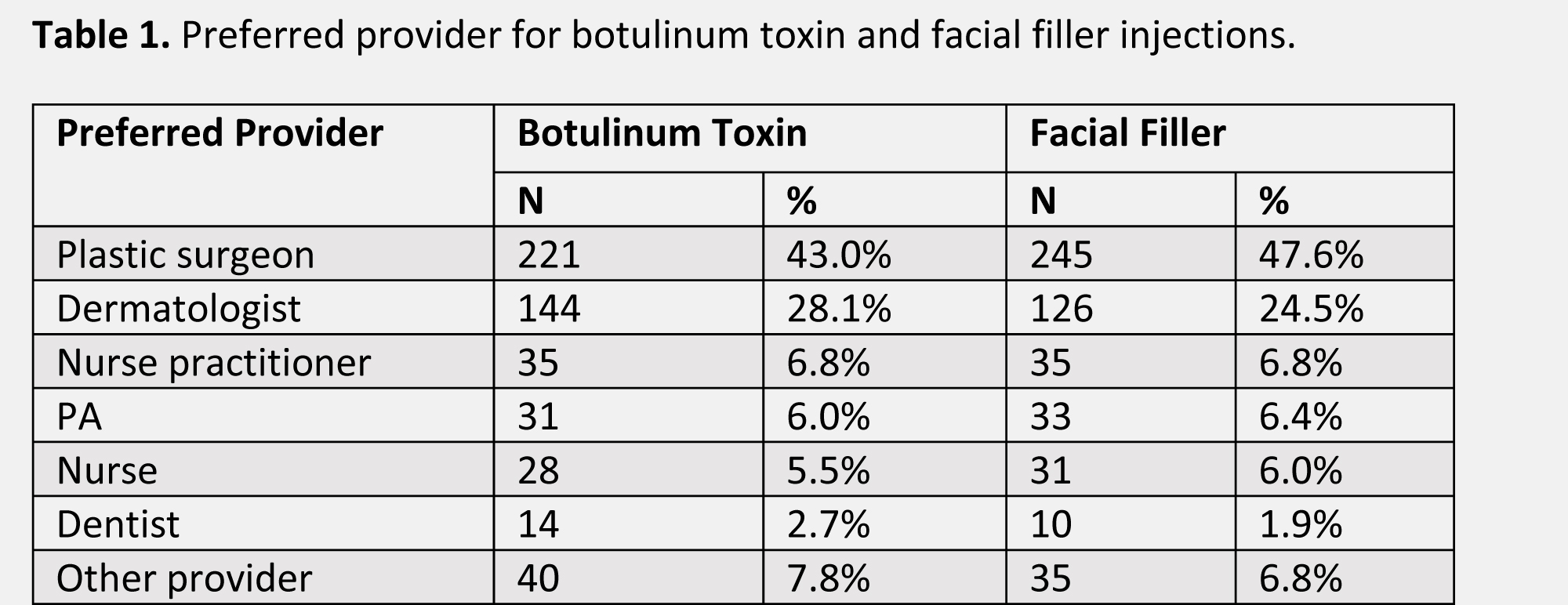Public Perspectives on the Safety of Botulinum Toxin and Facial Filler Injections
Natalie E. Hassell, BA1; Valeria P. Bustos, MD1; Nicholas Elmer, BS1; Carly D. Comer, MD1; Samuel M. Manstein, MD1; Samuel J. Lin, MD, MBA1
1. Division of Plastic Surgery, Beth Israel Deaconess Medical Center, Harvard Medical School, Boston, MA
Background: Though both botulinum toxin and facial filler injections are safe procedures with high efficacy and patient satisfaction, it is unclear how knowledgeable the general public is about their risks. The goal of this study was to assess public knowledge of the risks of botulinum toxin and facial filler injection as well as comfort with various providers delivering these injections.
Methods: A cross-sectional survey was performed through Amazon Mechanical Turk regarding knowledge of the risks of botulinum toxin and facial filler injection and provider preferences among adults 18 years and older and residing in the United States.
Results: A total of 498 complete, unique responses were analyzed. The average age of respondents was 38.8 years and 61% of respondents self-identified as female. Thirty-four percent of respondents previously received botulinum toxin injections and 22% received facial filler. Moreover, 69% and 51% would consider botulinum toxin or filler injections, respectively. When asked to identify potential risks of botulinum toxin injections from a list, asymmetry, bruising, and drooping of parts of the face were correctly identified by 38%, 50%, and 49% of respondents, respectively. Asymmetry, bruising, blindness, and blood vessel clotting (vascular occlusion) were identified as risks of filler injection by 40%, 51%, 18%, and 19% of respondents, respectively. Plastic surgeons were the most preferred provider for botulinum toxin and facial filler injections, preferred by 43% and 48% of participants respectively. Dermatologists were the next most preferred provider, selected by 28% of participants for botulinum toxin and 24% for facial fillers. Participants were also asked to rate their knowledge of these injections. Those with higher self-rated knowledge had lower odds of selecting a plastic surgeon or dermatologist as their preferred provider for botulinum toxin (OR .35, 95% CI .23-.51, p<0.0001) or filler injections (OR .34, 95% CI .20-.57, p<0.0001).
Conclusion: While most people would consider botulinum toxin or facial filler injections, the risks of these procedures are poorly appreciated by the general public. Though most people would elect to see a plastic surgeon for these procedures, those with a higher self-rated knowledge of their risks may prefer non-physician providers. This may be due to high self-rated knowledge reflecting high confidence in the safety of these procedures; further inquiry is needed to understand this relationship or elucidate other potential influences. Plastic surgeons must continue to advocate for the safe and informed delivery of botulinum toxin and facial fillers.
Back to 2022 Abstracts

